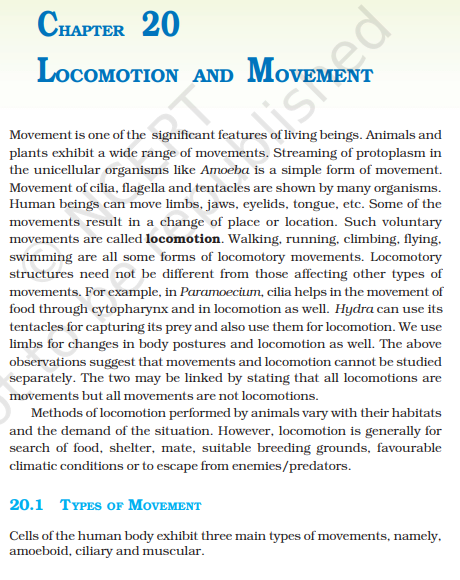‘NCERT Solutions for Class 11 Biology Chapter 20 Locomotion And Movement’ PDF Quick download link is given at the bottom of this article. You can see the PDF demo, size of the PDF, page numbers, and direct download Free PDF of ‘Ncert Class 11 Biology Chapter 20 Exercise Solution’ using the download button.
Locomotion And Movement NCERT Textbook With Solutions PDF Free Download

Chapter 19: Locomotion and Movement
Movement is one of the significant features of living beings. Animals and plants exhibit a wide range of movements. Streaming of protoplasm in unicellular organisms like Amoeba is a simple form of movement.
The movement of cilia, flagella, and tentacles is shown by many organisms. Human beings can move limbs, jaws, eyelids, tongues, etc.
Some of the movements result in a change of place or location. Such voluntary movements are called locomotion.
Walking, running, climbing, flying, and swimming are all some forms of locomotory movements. Locomotory structures need not be different from those affecting other types of movements.
For example, in Paramoecium, cilia help in the movement of food through the cytopharynx and in locomotion as well. Hydra can use its tentacles for capturing its prey and also use them for locomotion.
We use limbs for changes in body postures and locomotion as well. The above observations suggest that movements and locomotion cannot be studied separately.
The two may be linked by stating that all locomotions are movements but all movements are not locomotions.
Methods of locomotion performed by animals vary with their habitats and the demand of the situation.
However, locomotion is generally for the search for food, shelter, mate, suitable breeding grounds, favorable climatic conditions or to escape from enemies/predators.
20.1 Types of Movement
Cells of the human body exhibit three main types of movements, namely, amoeboid, ciliary and muscular.
Some specialized cells in our body like macrophages and leucocytes in blood exhibit amoeboid movement.
It is affected by pseudopodia formed by the streaming of protoplasm (as in Amoeba). Cytoskeletal elements like microfilaments are also involved in the amoeboid movement.
Ciliary movement occurs in most of our internal tubular organs which are lined by ciliated epithelium.
The coordinated movements of cilia in the trachea help us in removing dust particles and some of the foreign substances inhaled along with the atmospheric air.
Passage of ova through the female reproductive tract is also facilitated by the ciliary movement.
The movement of our limbs, jaws, tongue, etc, requires muscular movement.
The contractile property of muscles is effectively used for locomotion and other movements by human beings and the majority of multicellular organisms.
Locomotion requires a perfect coordinated activity of muscular, skeletal, and neural systems. In this chapter, you will learn about the types of muscles, their structure, the mechanism of their contraction, and important aspects of the skeletal system.
| Author | NCERT |
| Language | English |
| No. of Pages | 13 |
| PDF Size | 4.4 MB |
| Category | Biology |
| Source/Credits | ncert.nic.in |
NCERT Solutions Class 11 Biology Chapter 20 Locomotion and Movement
4. Write true or false. If false change the statement so that it is true.
(a) Actin is present in the thin filaments
(b) H-zone of striated muscle fiber represents both thick and thin filaments.
(c) Human skeleton has 206 bones.
(d) There are 11 pairs of ribs in man.
(e) Sternum is present on the ventral side of the body.
Solution:
(a) Actin is present in thin filament – True
(b) H-zone of striated muscle fiber represents both thick and thin filaments – False
Corrected statement: H-zone of the striated muscle fiber represents only thick filaments
(c) Human skeleton has 206 bones – True
(d) There are 11 pairs of ribs in man – False
Corrected statement: There are 12 pairs of ribs in man.
(e) Sternum is present on the ventral side of the body – True
5. Write the difference between:
(a) Actin and Myosin
(b) Red and White muscles
(c) Pectoral and Pelvic girdle
Solution:
The differences are as follows:
a) Actin and myosin
| Actin | Myosin |
| Thin filaments (I-bands) of the myofilament are formed | Thick filaments (A-bands) of the myofilament are formed |
| It is built of globular actin monomers | It is built of meromyosin monomers |
| The regulatory proteins Troponin and tropomyosin are linked with the actin | The regulatory proteins are not linked, instead, each of the meromyosins is built of four light chains and two identical heavy chains |
b) Red and white muscles
| Parameters | Red muscles | White muscles |
| Myoglobin content | High | Low |
| Amount of sarcoplasmic reticulum | Moderate | High |
| Fibers | Narrow and thin | Broad and thick |
| Mitochondria | Possess many | Few |
| Fatigue | Not fatigued | Fatigued |
| Type of respiration from which energy is derived | Aerobic | Anaerobic |
c) Pectoral and Pelvic girdle
| Pectoral girdle | Pelvic girdle |
| The pectoral girdle is called the shoulder girdle | The pelvic girdle is called the hip girdle |
| Each part/half of the girdle consists of two bones – clavicle and scapula | Each part/half of the girdle consists of three bones – ischium, ilium, and pubis |
| Forelimb articulation is offered | Hindlimb articulation is offered |
| The Head of the humerus articulates with the glenoid cavity of the pectoral girdle | The Head of the femur articulates with the acetabulum of the pelvic girdle |
6. Match Column I with Column II:
| Column I | Column II |
| (a) Smooth muscle | (i) Myoglobin |
| (b) Tropomyosin | (ii) Thin filament |
| (c) Red muscle | (iii) Sutures |
| (d) Skull | (iv) Involuntary |
Solution:
| Column I | Column II |
| (a) Smooth muscle | (iv) Involuntary |
| (b) Tropomyosin | (ii) Thin filament |
| (c) Red muscle | (i) Myoglobin |
| (d) Skull | (iii) Sutures |
7. What are the different types of movements exhibited by the cells of the human body?
Solution:
Movement is considered to be one of the fundamental characteristics which are observed in the living entities. The different types of movements exhibited by the human body cells are:
1. Amoeboid Movement – Leucocytes found in blood exhibit this type of movement. Leucocytes from the circulatory system move towards the injury site when there is damage to the tissue in order to initiate an immune response.
2. Muscular movement – The muscle cells exhibit this type of movement
3. Ciliary movement – Sex cells (sperms and ova) exhibit this type of movement. This movement facilitates the passage of the ova via the fallopian tube on its way to the uterus.
NCERT Class 11 Biology Textbook Chapter 20 Locomotion and Movement With Answer PDF Free Download
